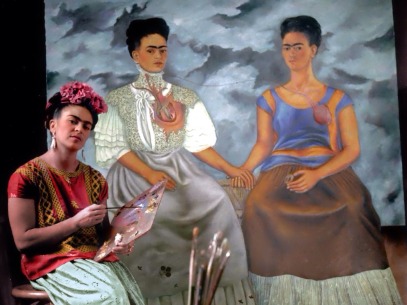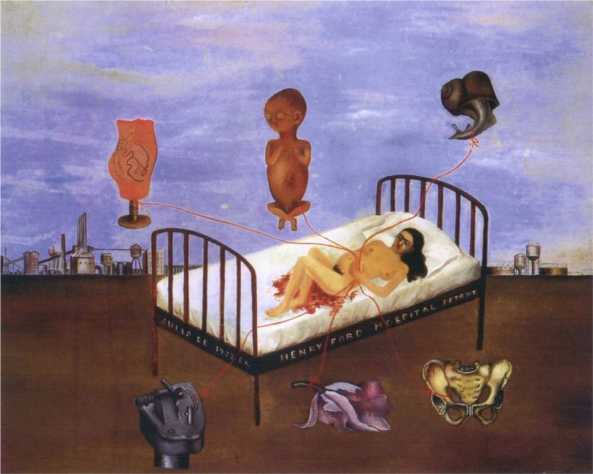
These two spirits “con la tea en la mano,” light up what needs to be lit up, torch what needs to be torched. They are the guerrilla goddesses Frida Kahlo and Julia de Burgos. They are my muses, my guides. I follow them wherever they take me.
 I was not allowed to paint them till I knew their pain. For six years I carried the idea in my body. Las Dos Fridas with its open-heart wounds, blood vessels as connective threads reinterpreted as a solidarity image of the two mujeres, and our two patrias. It wasn’t until my womb washed out a fetus unviable, birthing a child unborn, returning it to the sea, that I found the way, that I found the wall. I found it in a garbage-dumped-lot turned barrio sanctuary by community member Modesto “Tin” Flores. Beyond a garden creek carved from concrete that flowed with water and turtles. Behind a woman’s-womb-fountain sculpted by colombiana Lina Puerta. It was there where I was invited, empty womb in tow, toddler in hand, to consider this wall that I refused because of the iron bars and perpetually locked gate that surround it. But they, Julia and Frida, Yemaya y Oshun said it was not option. It was time. It was here. Solidarity forces standing in sisterhood not just in our triumph and victory but in our struggle and pain. So I started to paint.
I was not allowed to paint them till I knew their pain. For six years I carried the idea in my body. Las Dos Fridas with its open-heart wounds, blood vessels as connective threads reinterpreted as a solidarity image of the two mujeres, and our two patrias. It wasn’t until my womb washed out a fetus unviable, birthing a child unborn, returning it to the sea, that I found the way, that I found the wall. I found it in a garbage-dumped-lot turned barrio sanctuary by community member Modesto “Tin” Flores. Beyond a garden creek carved from concrete that flowed with water and turtles. Behind a woman’s-womb-fountain sculpted by colombiana Lina Puerta. It was there where I was invited, empty womb in tow, toddler in hand, to consider this wall that I refused because of the iron bars and perpetually locked gate that surround it. But they, Julia and Frida, Yemaya y Oshun said it was not option. It was time. It was here. Solidarity forces standing in sisterhood not just in our triumph and victory but in our struggle and pain. So I started to paint.
I painted away the pain. I painted our fetuses along the top border. In between them, I painted Julia’s words: Como naciste para la claridad, te fuiste no nacido. Pie fertil caminando para siempre sobre la tierra. (Since you were born for clarity, you left unborn. Fertile foot forever walking the earth.) I painted the pain from my womb. These goddess in turn filled my womb with life again. I discovered midway that there was a Baby Josef accompanying me each day to paint, fueling my womb, my second chakra, the seat of creative energy.
For Josef’s fifth birthday this past February we took him to el Museo del Niño in Carolina. Actually he was sick for his birthday so we went a week later, around the time this island also commemorates Julia de Burgos birthday (February 17th). Sometime during that trip I realized that we were just minutes away from her mausoleum. I remember walking up the street to the corner where her statue sits. I approached the statue as if it were the embodiment of Julia herself. The statue is imbued with her aché, her energy. I sat at her feet contemplating the power that is her, staring out into a channel of el Rio Grande de Loíza flowing out into the sea. Around her were pillars, each bearing a plaque with a different poem of hers. As I began walking down a path towards her mausoleum Julia and I were back to back. I felt her calling me so I stopped to look back. I found myself face to face with a plaque I hadn’t noticed. I read the title “Poema del hijo no nacido.” Eyes welled with tears, I went on to read the first line: Como nacistes para la claridad, te fuiste no nacido….

Fast forward to June when I was invited to participate in the Puerto Rico/ Detroit Solidarity Network Gathering as part of the Allied Media Conference. I traveled to Detroit with nothing but the conference on my mind. Closing out a teaching position, I hadn’t been able to consider much more aside from the conference. It was a short stay so I hadn’t planned on seeing anything else on this first trip there. But random voices insisted that I make it out to the museum. One particular brother insisted I go and made sure I got there. I, still on my AMC high, walked to the Detroit Institute of the Arts, past the theater we had packed the night before, all chanting “wage love”. On the way in, I stopped at Rodin’s The Thinker.

With limited time before my flight out, we headed straight to Diego Rivera’s epic mural. Upon entering the courtyard, every hair was standing on my skin. The magic and spirit that filled the space was overwhelming. Immediately I zoomed in on the fetus floating above the doorway. I stood beneath it and began breathing deeply, almost panting.
Wait! I had known about this mural. I had known bits and pieces. I had never put it all together. I was led there so that I could hurry up and do so.
Wait! This is her baby! This is Frida’s baby! A scene flashed in my mind, riding in someone’s car two days before, my eyes locking with a sign that read “Ford Hospital,” not registering the tall building at the time.

Wait! This is Detroit.
It was here. It was here….
A feeling of repulsion filled my stomach.
She hated it here.
Nausea…
Tears….
Ford Hospital…
It was here… It was here…
It has to be from here,
right this instance,
my cry into the world.
-Julia de Burgos “Farewell from Welfare Island” excerpt

July 4th, 1932 legendary Mexican painter Frida Kahlo, accompanying her husband Diego Rivera during his 11-month residency painting the epic Mural “Detroit Industry” at the Detroit Institute of Arts, suffered a miscarriage. She had been ordered to stay on bed rest in order to carry the baby to term, but her body still began the process of miscarriage. Taken to the Henry Ford Hospital in Detroit, the aborting process that was started by her own body was completed by doctors. Frida depicts this literal gut-wrenching scene in her 1932 powerful painting “Henry Ford Hospital.”

Life was somewhere forgotten
and sought refuge in depths of tears and sorrows;
over this vast empire of solitude and darkness.
-JDB “Farewell…” excerpt
The Ford Motor Company is incorporated into the background of Kahlo’s painting. Henry Ford’s only son had ironically commissioned the famous Mexican muralist, Diego Rivera, (a communist whose ideals ran counter to that of Ford’s) paying him $20,000 for the piece during the heart of the depression and labor strikes across Detroit. Rivera was impressed by his patron and the modern industry of the city. Frida despised them all: the big city, the rich, the depression, the injustices, capitalism, industrialization, colonialism. In an odd twist she lost her baby on the day that the United States, which conquered half of her Mexico in 1848, celebrates its independence.
Where is the voice of freedom,
freedom to laugh, to move
without the heavy phantom of despair?
-JDB “Farewell…” excerpt
Frida’s July 4th miscarriage happened just two days before her birthday, July 6th. In 1953, Julia de Burgos passed away in New York on Frida Kahlo’s birthday.

Frida would live just one more year, having written: “Espero alegre la salida y espero no volver jamás.” (I happily await the exit. I hope never to return). I commemorated the legacies of both mujeres by unveiling the Soldaderas mural on that day in 2011. In 2017 I was led to Julia de Burgos’ mausoleum where I read on a plaque the very words I cited on the mural. While in Detroit for the AMC conference I was also led to the mural where Diego honors his and Frida’s lost child and the spiritual heritage of Mexico within a complex narrative of the contradictions of industrialization. Today Detroit, (the city that Frida and Diego left their immortal mark on) and Julia’s Puerto Rico, battle colonialism; gentrification; the displacement and oppression of black and indigenous communities; corporatization; the contamination and exploitation of water and other natural resources; and harsh austerity measures of Emergency Management and La Junta fiscal oversight boards.
Mexican painter Frida Kahlo and Puerto Rican Poet Julia de Burgos, their work, their lives, their legacies are still a light for us all. If you are ever in el Barrio in New York City, strolling along Lexington Avenue near 104th Street and see these mujeres gazing out from the Soldaderas mural, please give them my love and yours. If you must view them through iron bars and a locked iron gate, think of the people of Borikén and her sister islands, still colonized. They urge us all to decolonize ourselves and our people. They continue hand in hand, in solidarity, struggling alongside us until victory.

To learn more about the Soldaderas mural: www.yasminhernandezart.com/soldaderas
Special thanks to brother Eroc. Frida called upon him to carry out a Frida tour and lead a sista to this mural. Learn more about his work with Foundation Movement.

Leave a comment